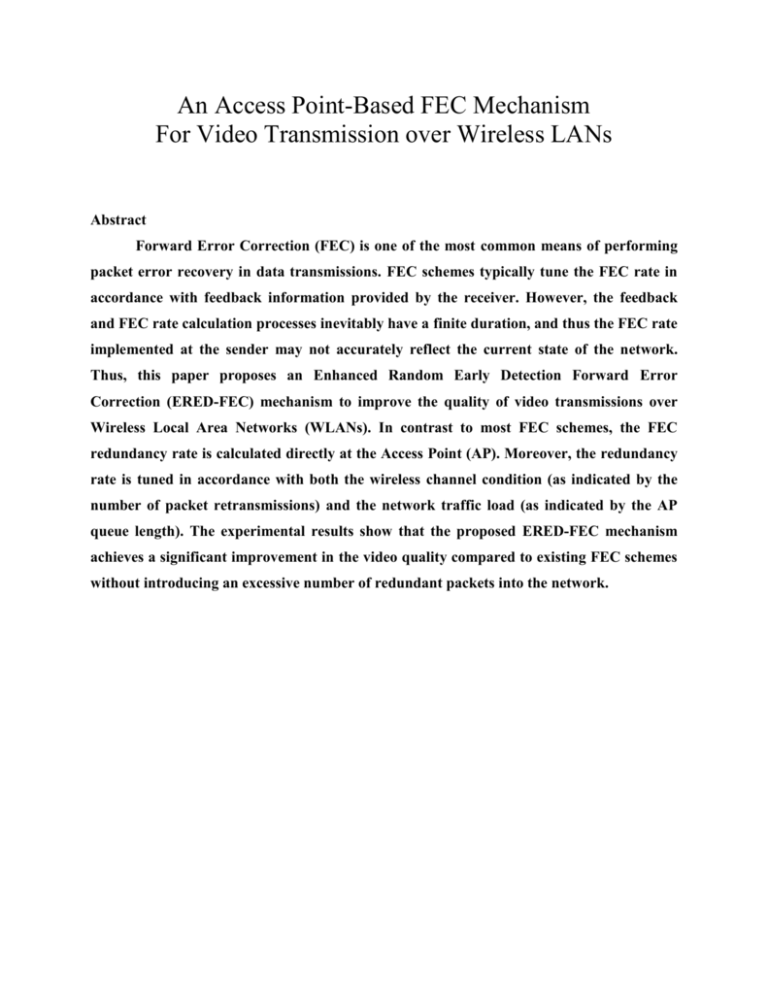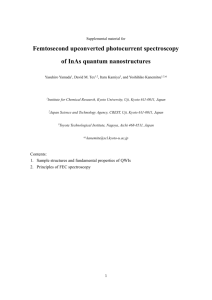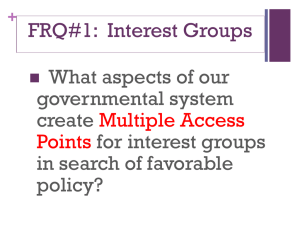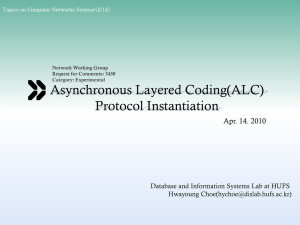An Access Point-Based FEC Mechanism For Video Transmission
advertisement

An Access Point-Based FEC Mechanism For Video Transmission over Wireless LANs Abstract Forward Error Correction (FEC) is one of the most common means of performing packet error recovery in data transmissions. FEC schemes typically tune the FEC rate in accordance with feedback information provided by the receiver. However, the feedback and FEC rate calculation processes inevitably have a finite duration, and thus the FEC rate implemented at the sender may not accurately reflect the current state of the network. Thus, this paper proposes an Enhanced Random Early Detection Forward Error Correction (ERED-FEC) mechanism to improve the quality of video transmissions over Wireless Local Area Networks (WLANs). In contrast to most FEC schemes, the FEC redundancy rate is calculated directly at the Access Point (AP). Moreover, the redundancy rate is tuned in accordance with both the wireless channel condition (as indicated by the number of packet retransmissions) and the network traffic load (as indicated by the AP queue length). The experimental results show that the proposed ERED-FEC mechanism achieves a significant improvement in the video quality compared to existing FEC schemes without introducing an excessive number of redundant packets into the network. Existing System The lost packets during timeouts, or in response to explicit receiver requests. By contrast, in FEC schemes, the effects of potential packet losses are mitigated in advance by transmitting redundant packets together with the source packets such theta block of packets can be successfully reconstructed at the receiver end even if some of the packets within the block are lost during transmission. Of the two approaches, FEC schemes result in a lower retransmission latency, and are therefore widely preferred for the delivery of video streams over wireless networks Conventional FEC mechanisms are sender-based, i.e., the redundant packets are generated and encoded at the sender end. Broadly speaking, sender-based FEC schemes can be categorized as either Static FEC (SFEC) or Dynamic FEC (DFEC). In SFEC schemes, the number of redundant packets added to the source packets remains constant irrespective of changes in the network condition. The recovery performance of SFEC schemes is therefore somewhat unpredictable because they fail to capture the real-time network conditions and adjust the FEC redundancy rate accordingly. Disadvantages The FEC rate is tuned dynamically in accordance with changes in the channel condition or network load. In most DFEC schemes, the FEC rate is tuned at the sender based on information provided by the receiver. The FEC redundancy rate is traditionally calculated at the application layer based on feedback information such as that provided by acknowledgement messages. Proposed System The evaluating the impact of packets losses on the percentage of successfully decoded frames at the receiver end. To calculate the error propagation due to packet losses, the interdependencies of the coded frames must be considered. The MPEG-4 standard defines three frame types for compressed video streaming, namely I frame P frame (Predictive-coded) and B frame. I frames are encoded and decoded independently of any other frames in the sequence. The number of FEC redundant packets generated by the four schemes under light and heavy traffic loads, respectively. In the case of a light load, the number of FEC redundant packets generated by the SFEC and RED-FEC schemes remains approximately constant as the packet loss rate increases since neither scheme considers the channel condition when evaluating the FEC redundancy rate. By contrast, the ACFEC and ERED-FEC schemes both consider the packet loss rate when determining the FEC redundancy rate, and thus for both algorithms, the number of redundant packets increases with an increasing packet loss rate. In the case of a heavy load, the number of FEC redundant packets generated by the SFEC and ACFEC algorithms is the same as that generated for a light traffic load since both algorithms ignore the effects of congestion when determining the FEC redundancy rate. Advantages The ACFEC and ERED-FEC schemes, no appreciable degradation in the DFR or PSNR occurs since both schemes take account of the packet loss rate when computing the number of FEC redundant packets per block. The video quality without overloading the network with redundant packets. The experimental results have shown that the ERED-FEC scheme yields a higher Decodable Frame Rate (DFR) and Peak Signal-to-Noise. Module Description Adaptive Cross-layer FEC mechanism (ACFEC) The proposed an Adaptive Cross-layer FEC mechanism (ACFEC) in which loss information was retrieved from the ARQ function of the MAC layer and the redundancy rate was controlled adaptively in accordance with changes in the network condition. However, ACFEC does not take the effect of the network traffic load into consideration. As a result, packets may be lost at the wireless AP under heavy network loads due to a self-induced congestion problem. Enhanced Random Early Detection Forward Error Correction (ERED-FEC) The proposes an Enhanced Random Early Detection Forward Error Correction (EREDFEC) mechanism for improving the quality of video transmissions over wireless LANs (WLANs). In the proposed approach, redundant FEC packets are generated dynamically at the AP in accordance with both the condition of the wireless channel and the current network traffic load. The channel condition is evaluated by monitoring the number of packet retransmissions. As the number of retransmissions increases the condition of the wireless channel deteriorates), a greater number of redundant FEC packets are generated. Conversely, as the channel condition improves, the number of FEC packets is reduced. Forward Error Correction (FEC) The basic principle of FEC entails injecting redundant packets into the video stream together with the source Thus, provided that no more than packets are lost in transmission, the source transmission packets can be successfully recovered at the receiver. Since FEC schemes enable the recovery of source packets which would otherwise be lost, the effective loss rate in the transmission network is lower than the actual loss rate. In FEC codec, redundant packets are derived from the original packet using conventional coding theory techniques. Of the various traditional error correcting codes available for this purpose, Reed-Solomon (RS) code has attracted particular interest. RS code provides an ideal error protection capability against packet losses since it is a maximum distance separable code, no other coding scheme exists capable of recovering lost source data symbols from a lesser number of received code symbols. Sender-Based FEC Mechanisms The proposed a sender-based Constant Error Rate FEC (CER-FEC) scheme for enabling the dynamic QoS control of real-time multimedia streams over heterogeneous environments comprising wired and wireless connections. As shown in the proposed scheme, the packet error rate is periodically observed at the receiver side and any change in the error rate is fed back to the sender. Upon receiving this information, the sender calculates the number of redundant packets required to restore the error rate to its original value. In other words, the FEC redundancy rate is dynamically controlled in such a way as to maintain a constant packet error rate at the receiver end. Contribution of Present The major contribution of the present study is to propose a new AP-based FEC mechanism (ERED-FEC) for improving thequality of video transmissions over wireless LANs (WLANs). The literature contains many proposals for sender-based FEC schemes which have a finite duration to feedback information from the receiver. Thus, the FEC rate determined at the sender end may not accurately reflect the current network condition. AP-Based FEC Mechanisms The number of redundant packets is increased as the queue length shortens, but is reduced as the queue length grows. Importantly, when the queue is near to full, no FEC packets are generated in order to avoid overloading the network. By adopting this approach, the RED-FEC mechanism improves the quality of the delivered video stream without injecting an excessive number of redundant packets into the network. Flow Diagram CONCLUSION This paper has presented an AP-based FEC mechanism (ERED-FEC) for improving the quality of video transmissions over WLANs. In contrast to many FEC schemes, in which the FEC rate is determined at the sender end on the basis of information provided by the receiver, in the FEC mechanism proposed in this study, the FEC redundancy rate is determined at the wireless access point (AP).Moreover, the FEC redundancy rate is calculated in accordance with both the wireless channel condition and the network traffic load. As a result, the ERED-FEC mechanism significantly improves the video quality without overloading the network with redundant packets. The experimental results have shown that the ERED-FEC scheme yields a higher Decodable Frame Rate (DFR) and Peak Signal-to-Noise Ratio (PSNR) than existing AP-based FEC mechanisms under both light and heavy network traffic loads. In a future study, the recovery performance of the ERED-FEC mechanism will be further enhanced by utilizing an FEC interleaving/ de-interleaving strategy. In addition, the feasibility of extending the EREDFEC scheme and networks will also be addressed. REFERENCES [1] D. J. Deng, C. H. Ke, Y. M. Huang, and H. H. Chen, “Contention window optimization for IEEE 802.11 DCF access control,” IEEE Trans. Wireless Commun., vol. 7, no. 12, pp. 5129– 5135, Dec. 2008. [2] K. J. Geun and M. M. Krunz, “Bandwidth allocation in wireless networks with guaranteed packet-loss performance,” IEEE/ACM Trans. Netw., vol. 8, pp. 337–349, 2000. [3] H. Zhihai and X. Hongkai, “Transmission distortion analysis for real-time video encoding and streaming over wireless networks,” IEEE Trans. Circuits Syst. Video Technol., vol. 16, pp. 1051–1062,2006. [4] A. Nafaa, Y. Hadjadj-Aoul, and A. Mehaoua, “On interaction between loss characterization and forward error correction in wireless multimedia communication,” in Proc. IEEE Int. Conf. Communications, ICC 2005, 2005, pp. 1390–1394. [5] E. Maani and A. Katsaggelos, “Unequal error protection for robust streaming of scalable video over packet lossy networks,” IEEE Trans. Circuits Syst. Video Technol., vol. 20, pp. 407– 416, 2010. [6] A. Argyriou, “Cross-layer error control for multimedia streaming in wireless/wireline packet networks FEC scheme for TDM-OFDMbased satellite radio broadcasting system,” IEEE Trans. Multimedia, vol. 10, pp. 1121–1127, Oct. 2008. [7] J. Dan, F. Pascal, and J. Aleksandar, “Forward error correction formultipath media streaming,” IEEE Trans. Circuits Syst. Video Technol., vol. 19, pp. 1315–1326, 2009.






